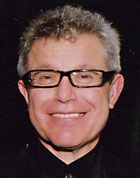Daniel Libeskind, master plan architect for the former World Trade Center site in New York City, will read from his new memoir, Breaking Ground: Adventures in Life and Architecture, at 7 p.m. Monday, Dec. 6, in Washington University’s Graham Chapel.

The reading — sponsored by Left Bank Books, the Contemporary Art Museum St. Louis and Washington University’s Sam Fox Arts Center and School of Architecture — is free and open to the public, though seating is limited. Doors open at 6:30 p.m. Graham Chapel is located on Washington University’s Hilltop Campus, immediately north of the Mallinckrodt Student Center, 6445 Forsyth Blvd. A booksigning will be held afterwards and Left Bank Books will have copies of Breaking Ground available for purchase. For more information, call (314) 935-6293.
Libeskind is one of the world’s most influential figures in architecture and urban design. Breaking Ground, written with Sarah Crichton, discusses his iconoclastic approach to public space, his ideas about tragedy and hope, and the way in which architecture can memorialize — and reshape — human experience. The book also shares Libeskind’s vision for the World Trade Center site, including his proposed 1776 Freedom Tower, a soaring, 1,776-foot-tall spire designed to restore New York’s “spiritual peak” while creating “an icon that speaks of our vitality in the face of danger and our optimism in the aftermath of tragedy.”
|
WHO: Architect Daniel Libeskind WHAT: Reading from his memoir, Breaking Ground WHEN: 7 p.m. Monday, Dec. 6; doors at 6:30 p.m. WHERE: Graham Chapel, just north of the Mallinckrodt Student Center, 6445 Forsyth Blvd. COST: Free SPONSORS: Left Bank Books, Contemporary Art Museum St. Louis, Washington University’s Sam Fox Arts Center and School of Architecture INFORMATION: (314) 935-6293 |
Born in Poland to Holocaust survivors in 1946, Libeskind became an American citizen in 1965, earning his undergraduate degree in architecture from Cooper Union in 1970 and a postgraduate degree in History and Theory of Architecture from the School of Comparative Studies at Essex University in 1972. A former director of Architectural Studies at the Cranbrook Academy of Art, he also has taught at the University of Toronto, Yale University, the University of Pennsylvania and the Karlsruhe Hochschule fur Gestaltung in Germany.
In 1989, Libeskind won the competition for the Jewish Museum Berlin and founded Studio Daniel Libeskind the following year. Even before the Jewish Museum opened, in 2001, Libeskind’s radical, strikingly asymmetrical design — filled with disorienting angles, underground passages and slit windows — became something of a legend in architecture circles, and many observers suggested that it remain empty, a monument to the void left by the Holocaust. Libeskind and museum director Michael Blumenthal, however, have noted such proposals defeat the project’s purpose, which is to pay homage to the rich cultural contributions of Germany’s Jewish community.
Other major built works include The Felix Nussbaum Haus (1998), a museum for the city of Osnabrück, Germany; the Imperial War Museum North in Manchester, England (2002); the London Metropolitan University Graduate Centre (2003); and the Danish Jewish Museum in Copenhagen (2004).

In addition to the World Trade Center master plan, Studio Daniel Libeskind is currently designing or constructing more than a dozen projects around the world. These include the Jewish Museum in San Francisco; extensions to the Denver Art Museum and the Royal Ontario Museum; the JVC University Colleges of Public Administration, Teaching and Art & Architecture in Guadalajara, Mexico; The Maurice Wohl Auditorium in Bar-Ilan, Irsrael; the Corporate Headquarters for Wohnbau Nordwest in Dresden, Germany; and the Dublin Docklands Grand Canal Performing Arts Centre and Galleria.
In addition to his design work, Libeskind has earned a reputation as one of the world’s preeminent architectural theorists. His previous books include Daniel Libeskind: The Space of Encounter (2001), Libeskind Speaks: Writings of Construction (1999) and Radix-Matix: Architecture and Writings (1997).
A member of the European Academy of Arts and Letters, Libeskind’s many honors include the German Architecture Prize (1999) and the Goethe Medal (2000). In 2001, he became the first architect to receive the Hiroshima Art Prize, given to an artist whose work promotes international understanding and peace.